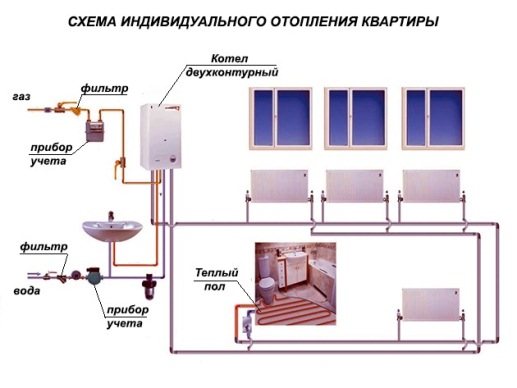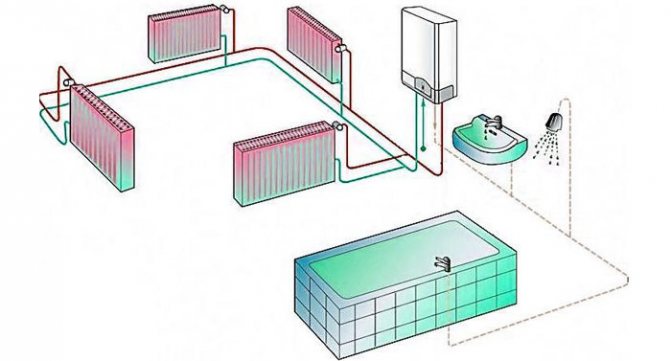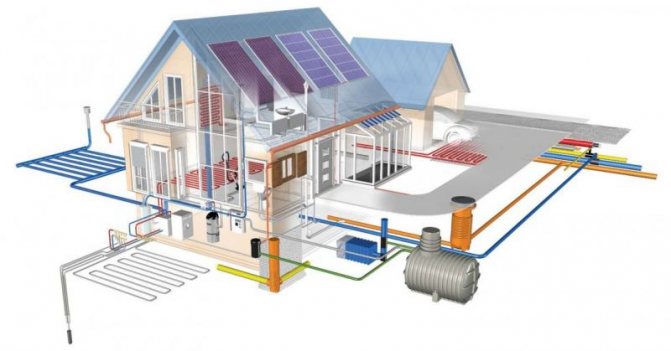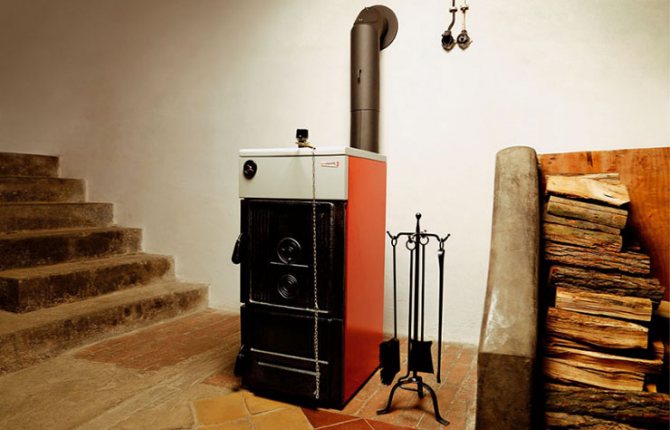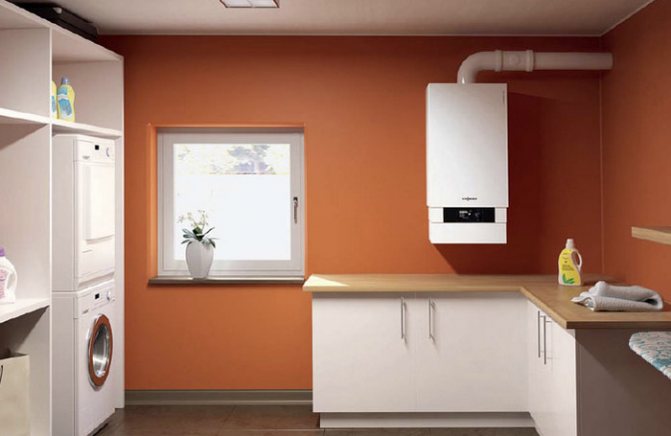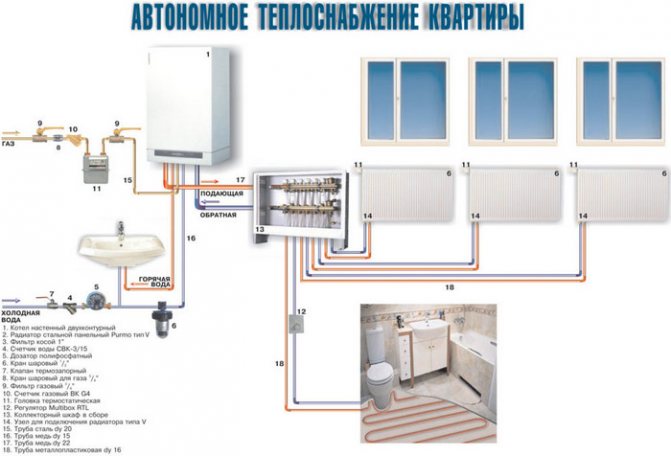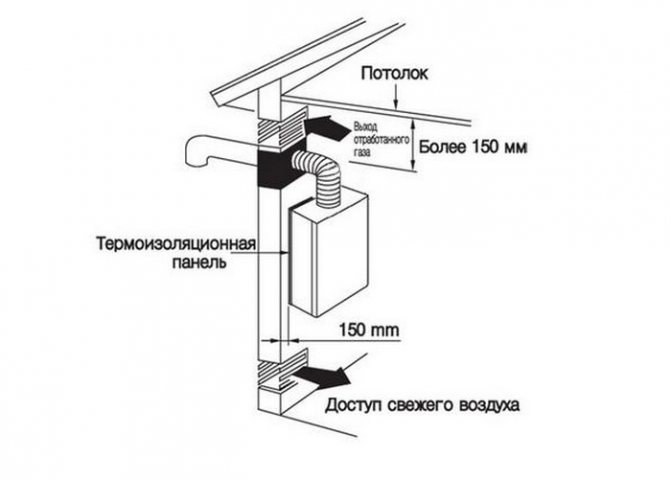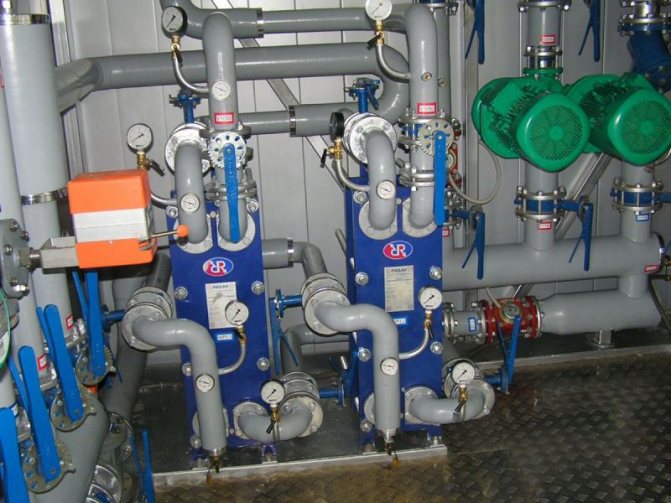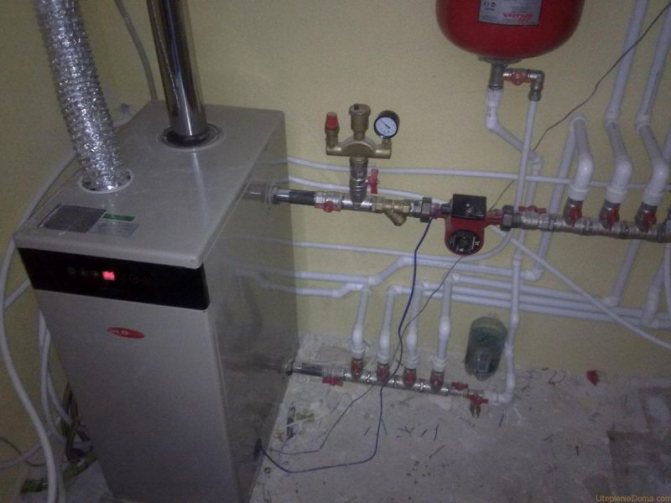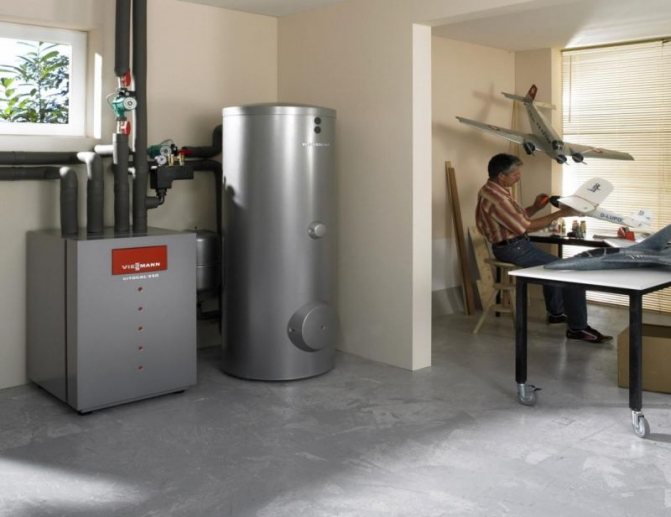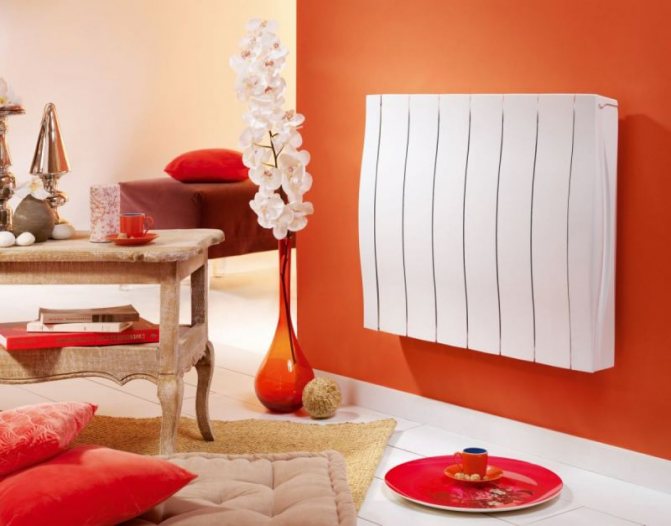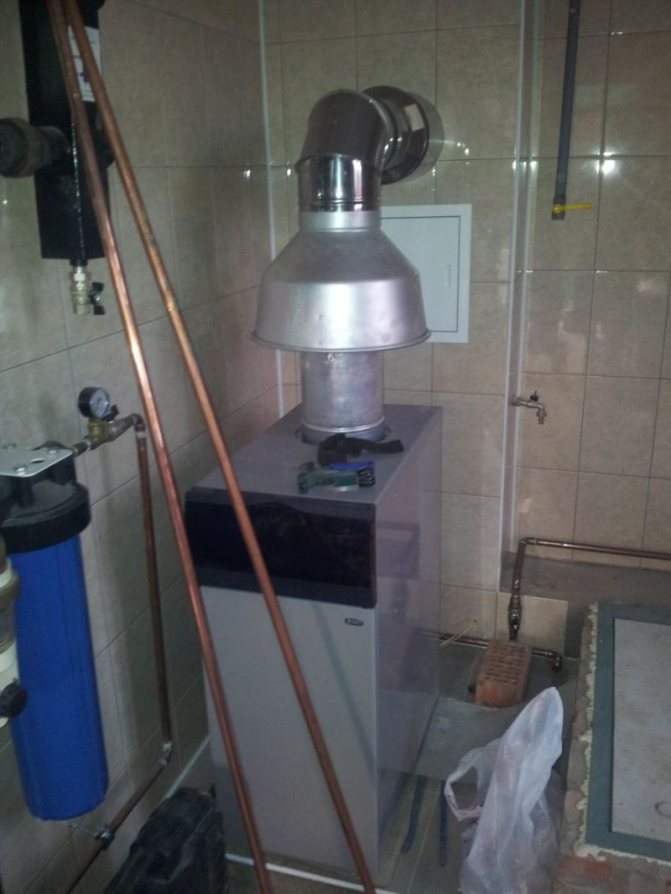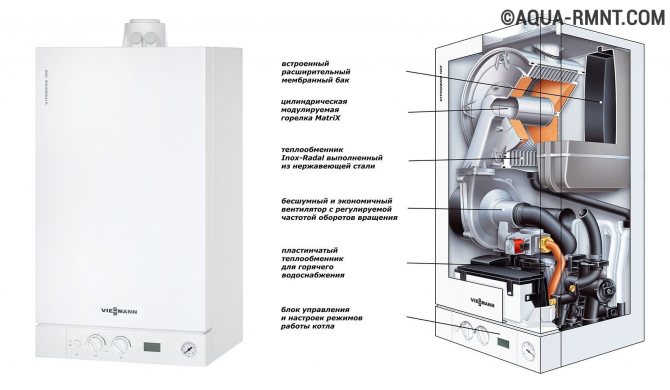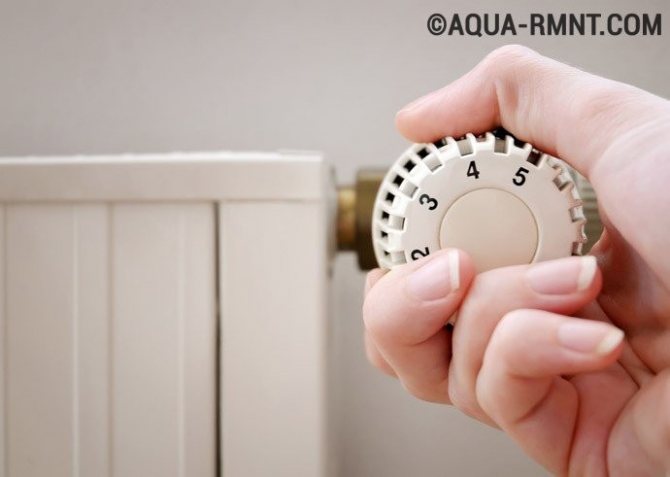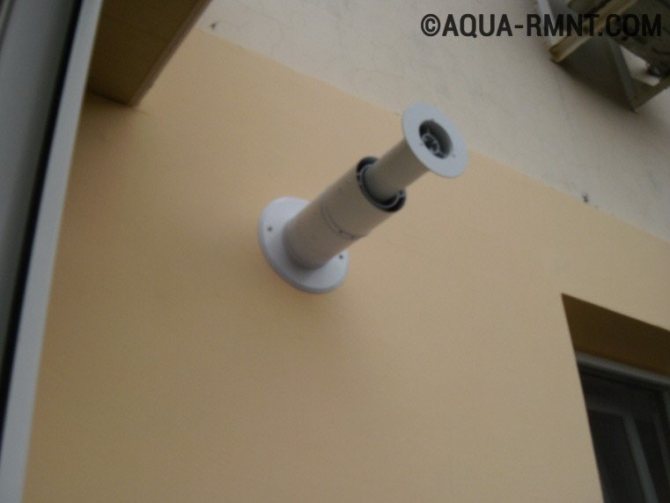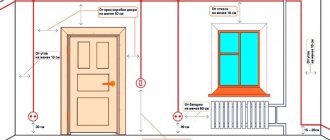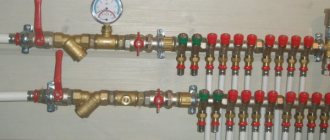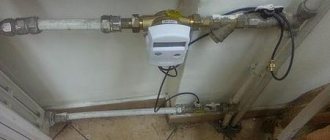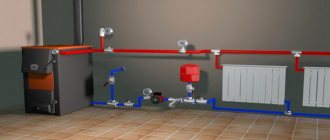Here you will find out:
- Features of individual heating of an apartment
- Algorithm for obtaining permission
- How to make a calculation
- Equipment for autonomous heating of an apartment
- Gas heating system device
- Installation of autonomous heating in the apartment
Before deciding on such a cardinal replacement, it is necessary to evaluate all the pros and cons of an individual heating system.
So, the advantages of having an autonomous heating system are as follows:
- The possibility of heating an apartment in the off-season, when the central system is not yet turned on or has already been turned off, in accordance with the established regional norms, which are based on the ambient temperature, at these times of the year is very unstable and with large daily fluctuations.
- The ability to maintain the required temperature regime in the rooms, which is much more difficult to organize with central heating, since it does not take into account the location of the apartment and the degree of its insulation. Probably, there is no need to explain that apartments located inside the house, and corner ones, moreover, exposed to the prevailing winter winds, still require a differentiated approach to heating. However, in order to balance consumption costs, heat bills are charged in the same way, usually based on the area of the apartment. The location of the apartments themselves and the rooms in them can vary significantly, which is reflected in the need for the amount of heat. With an autonomous heating system, this problem is easier to cope with.Therefore, by installing autonomous heating in apartments, you can and should immediately take into account the specifics of the location of the rooms, getting both a comfortable microclimate in any of them, and considerable savings in money.
- Autonomous heating is easy to customize the operating modes. For example, it makes no sense to heat "to the full" if at the moment all tenants are absent. It will only be more logical to maintain the required heating level. But by the time the owners arrive, the automation will “catch up” the heat so that the rooms have the optimum temperature.
- Modern autonomous heating systems can be controlled remotely, for example, using a smartphone
- Many modern control systems, in addition, are able to independently respond to changing weather conditions. They can also be controlled remotely using GSM or IP communication channels.
- A decrease in operating costs will also occur due to significantly lower energy consumption, since modern gas or electrical equipment is designed for optimal energy consumption - they have high efficiency rates approaching 100 percent.
- When installing a double-circuit boiler, it is quite possible to abandon the central hot water supply system, providing your family with hot water autonomously. This means that an apartment equipped with such a unit will not depend on the summer maintenance of hot water supply, and there will always be hot water in it.
- With an autonomous heating system, you will have to pay only for the actually consumed amount of energy carriers - according to the meter
- Another category of advantages is the fact that you have to pay for central heating in the summer, as it requires constant maintenance. Having installed an autonomous heating option, payments will be made only for a gas (or electric) meter, that is, it will be possible to directly monitor energy consumption and the cost of heating and hot water supply, analyze and find ways to further save.However, there are also considerable difficulties in transferring an apartment to individual heating, and they can be attributed to the disadvantages of its arrangement:
- All work must be carried out on a legal basis and in compliance with all the requirements necessary for this process. Unauthorized reconstruction, firstly, will not get rid of utility bills for heating and hot water supply. And secondly, it also threatens with serious administrative punishment in the form of a very rather large fine.
- There will be difficulties associated with the preparation of documentation for disconnecting from central communications, project development, as well as obtaining permission to install equipment.
- It will be necessary to allocate or equip a room with a proper ventilation system for the installation of the heating unit.
- Installation of the system belongs to the works of a rather high category of complexity.
- Considerable costs will be required, both in the paperwork and the purchase of everything necessary for the arrangement of autonomous heating and hot water supply. And this is without taking into account the installation work.
- All responsibility for carrying out operational and preventive measures, as well as for the safety of the system, rests entirely with the owner of the apartment. It should be borne in mind that all the named processes associated with autonomous heating will be controlled by the relevant specialized organizations, whose representatives the apartment owner will have to provide access to the installed equipment.
However, even taking into account all the upcoming difficulties and significant initial costs, an autonomous heating system is in all respects much more profitable than central heating and hot water supply. In practice, it will pay for itself quickly enough and will reliably serve for many years.
Installation of autonomous heating in an apartment: difficulties
As mentioned above, in the case of a private house, everything is much simpler. Here you can install both a gas and an electric boiler, as well as a liquid fuel and solid fuel. In a private house, no one forbids making a water floor or installing solar panels on the roof, a solar heating collector, or installing a heat pump in the house. Or you can even build a mini-boiler room next to a residential building.
But in an apartment, most of the options described are prohibited from doing, because:
- not every project from a practical or technical point of view is possible in a building with many tenants and in a limited area;
- it can harm the interests of neighbors;
- there are legal restrictions on such projects.
So, in an apartment it is simply not practical to install a solid fuel boiler, since there is no necessary room, and just a place to store fuel - firewood or coal. But the floors of buildings are usually not designed for such a significant additional load. As well as storing large amounts of combustible material in a living space, it is dangerous.
It is not allowed to install a warm water floor in the apartments of apartment buildings, only its electric version is allowed. However, first of all, when switching to autonomous heating in an apartment building, one has to face legal difficulties. Thus, in some regions, refusal from central heating is generally prohibited by local regulations.
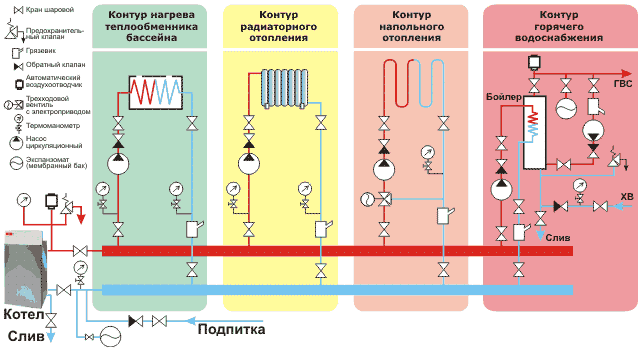
Autonomous heating system diagram
That is why it is necessary to start not with project documentation, but with a consultation with a lawyer. After all, it is possible that in order to make autonomous heating in an apartment building, permission will have to be obtained through the courts. In this case, such a permit is needed both for refusal of centralized heating, and for the installation of autonomous heating.
Varieties of autonomous heating systems
Electric heating
Autonomous heating based on electric heating boilers has a number of advantages, among which the following points must be noted:
- equipment reliability;
- relatively affordable cost of the boiler;
- noiselessness and harmlessness of work;
- the ability to install and connect equipment on their own.

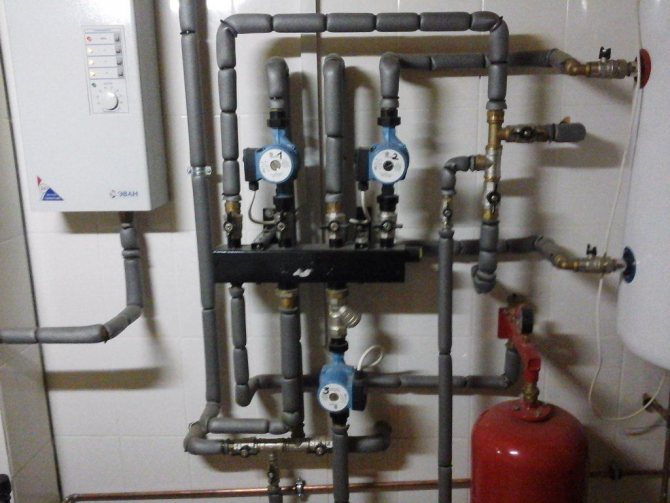
Electric heating
Modern heating elements, included in the design of heating boilers, serve more than 15-20 years. In addition, modern heating equipment has the ability to program the operating mode and the main parameters of the system.
Prices for popular electric boilers
Electric boiler
For example, the owner can program the boiler to turn on and off at a certain time, which is very convenient. To implement this function, air temperature sensors are used.
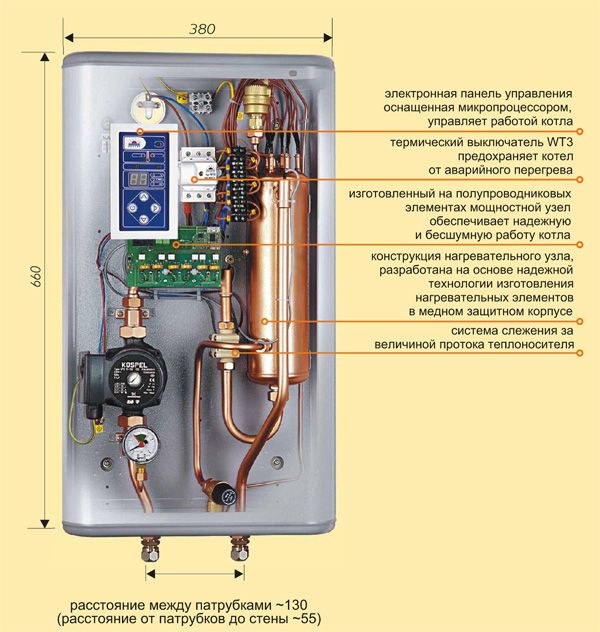

Modern electric boiler
As a result, autonomous heating, designed and equipped on the basis of an electric heating boiler, will be able to work without the intervention of the owner for weeks, or even whole months. It is this moment that determines the meaning of autonomy.
A fully-fledged autonomous system must be able to maintain the temperature regime at a given level, regardless of the weather outside the window.
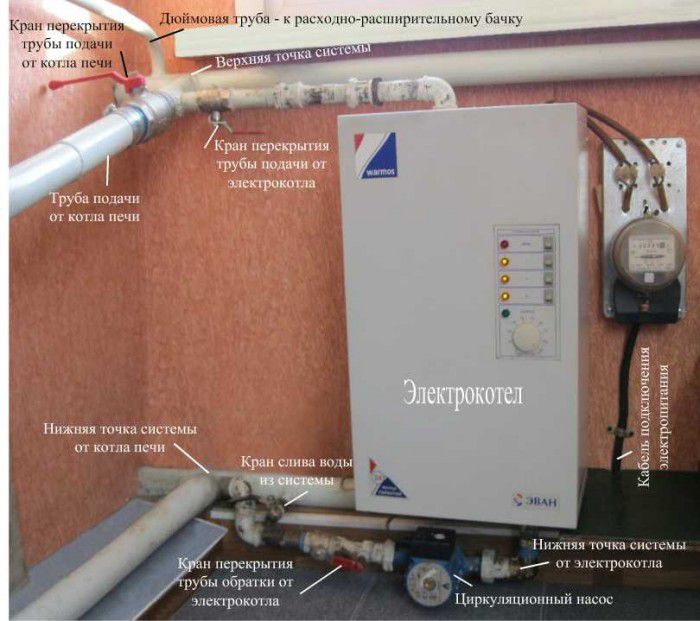

Electric boiler piping
However, electric heating has two significant disadvantages, namely:
- the system requires a stable power supply, and it is not present in all settlements. Electricity surges and its sudden outages can lead to the failure of the heating boiler;
- relatively high electricity tariffs. It is this moment that most often stops the owners, who are tuned in to the arrangement of electric heating, from implementing their ideas.
Gas heating
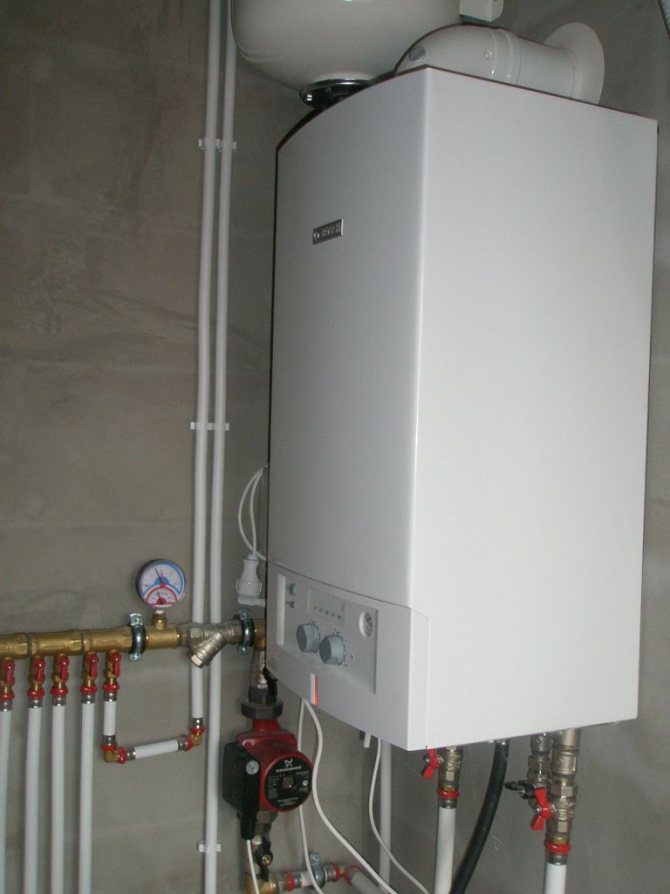

Gas heating
One of the more popular options. Provides the most economical heating due to the relatively low gas price. Such heating has no other significant advantages.
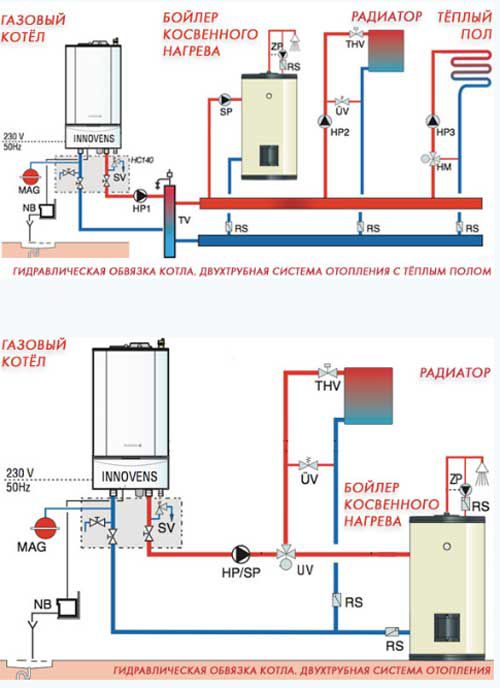

The most common gas heating schemes for a country house
There are many more disadvantages. Among them, the following points deserve special attention:
- equipment hazard;
- high cost of heating boilers;
- the need for regular maintenance by professionals.
In addition, the installation of a gas boiler and the arrangement on its basis of full-fledged autonomous heating can only be handled with special skills. To install such a boiler, you need to invite specialists, having previously obtained a number of permits from the relevant authorities.
Prices for popular gas boilers
A gas boiler
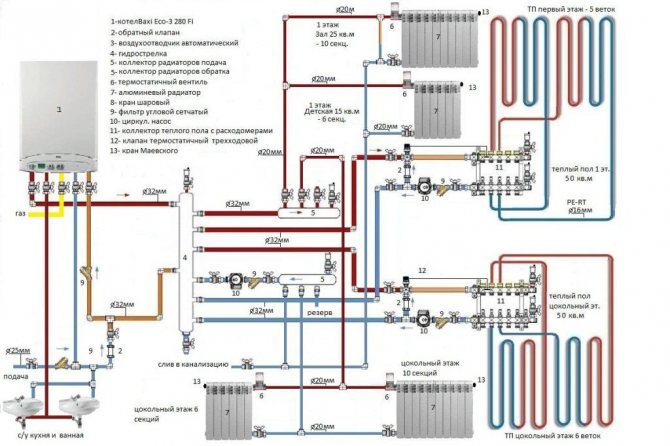

Gas heating
And gas pipelines are not laid in all settlements. In the absence of the possibility of connecting to the mains, there is no need to think about autonomous heating based on a gas boiler.
Liquid fuel heating
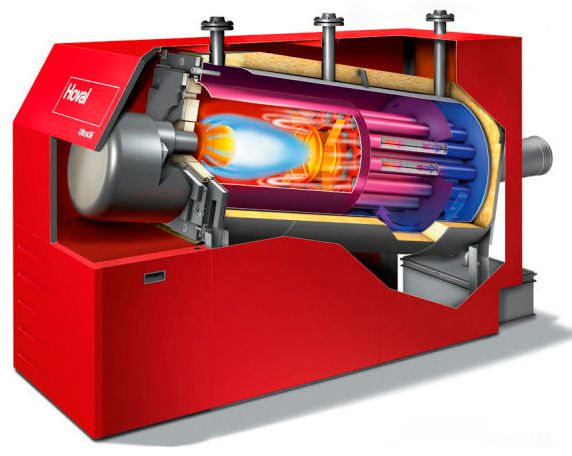

Condensing oil heating boiler
Liquid fuel boilers are categorically not suitable for the arrangement of permanent autonomous heating. Limitations are imposed by both the features of the heating equipment itself and the fuel used.
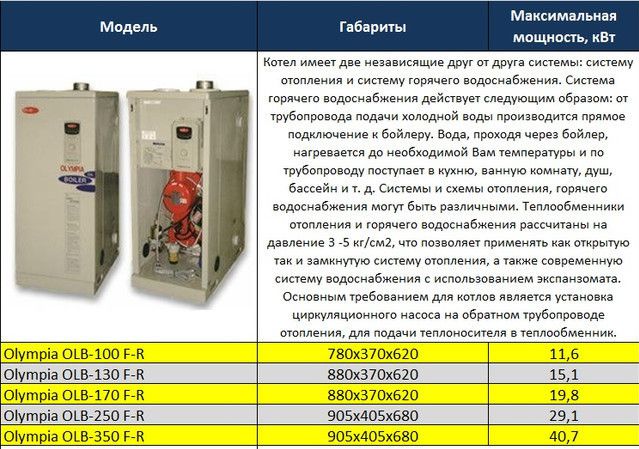

Oil-fired boilers
Also, among the significant disadvantages of such systems, it is imperative to include their electrical dependence and fire hazard. Therefore, liquid fuel heating systems can be considered exclusively as a backup and temporary source of heat.
Solid fuel heating
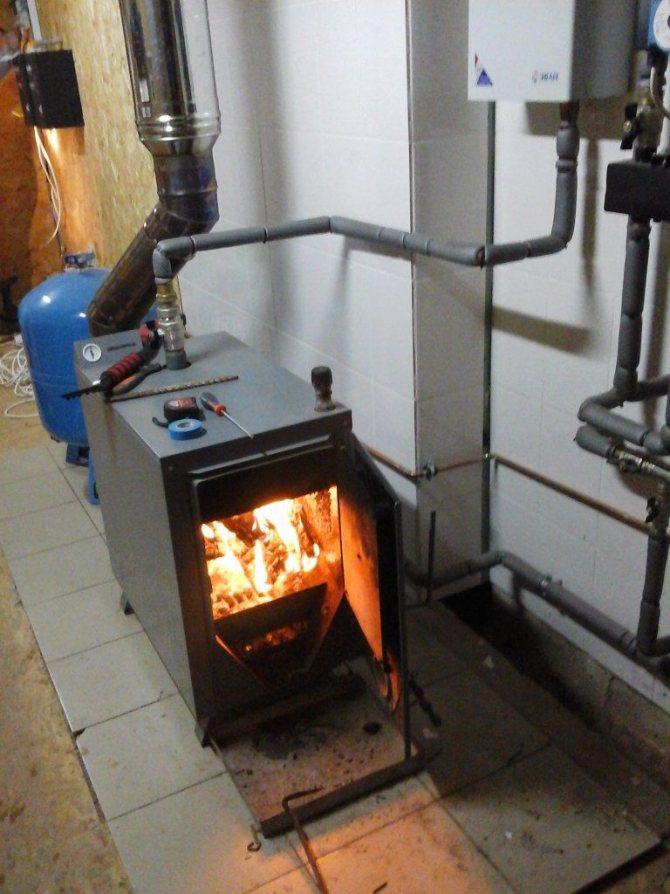

Solid fuel heating
One of the most ancient and widespread heating options. On the modern market, there is a large selection of solid fuel boilers suitable for arranging autonomous heating.
Prices for popular solid fuel boilers
Solid fuel boiler Lemax
The main advantage of such equipment is the efficiency of operation due to the relatively low cost of the energy carrier.
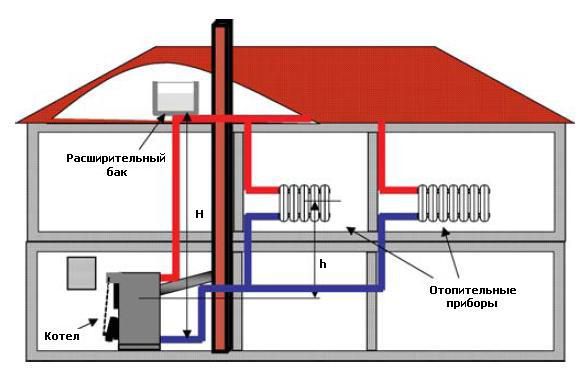

Solid fuel heating
Disadvantages include the need for storage space for fuel and the need for constant monitoring and maintenance.
Find out which are the best long-burning solid fuel boilers from our new article.
How can you provide heat supply for multi-apartment residential buildings
There are two options - to power the heat pipelines from the main heating networks or to install an autonomous heating point.
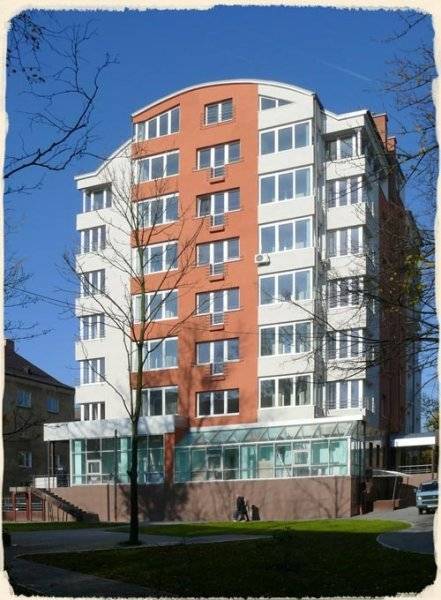

Modern technologies make it possible to provide autonomous heating for a house with many apartments.
Both options are good, but the presence of an individual heating point for several apartment buildings and autonomous heating with the use of energy-saving means will please more. Why?
Because the distance between the “heat point - consumer” pair is minimized, thereby reducing heat losses through the heating network. This type of heating is called decentralized, or autonomous.
Pros:
A lower percentage of costs for heating and hot water supply in an apartment building - and all because the costs of transporting and delivering the heat carrier to the end consumer are reduced.
Simply put, the source of heat supply is practically nearby, and therefore the time for supplying heat to residential buildings and the percentage of heat losses are reduced. This also results in a reduction in the cost of maintaining, servicing and repairing heating networks.
The efficiency of heat supply systems - as a consequence, follows from the previous factor. Since the source of heat supply is nearby, the amount of payment for utility services for hot water supply and heating is somewhat lower.
Independence from the citywide heating schedule. In other words, while heating has not yet been provided in the city (“because the heating season has not started according to the schedule”), and the temperature outside is already low, apartment heat supply from an autonomous heat source will come in handy.
In addition, each consumer will be able to choose the optimal temperature conditions for his apartment - turn off / turn on the heating system only for his apartment, adjusting the level of heat supply.
Lower cost and higher return on investment for new buildings with an autonomous heat supply source.
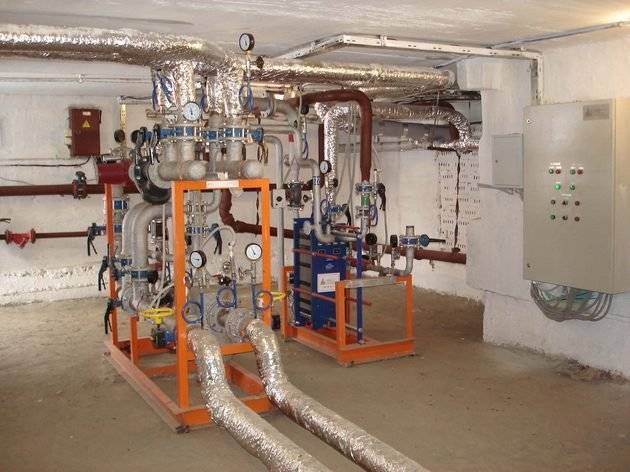

A separate boiler room in each house will increase the free space in the yard. Click to enlarge.
The presence of "additional free space" within the whole microdistrict. This also contributes to the implementation of housing programs, the construction of new buildings and the arrangement of microdistricts not for heating mains, but for the infrastructure of the districts.
In addition, the provision of apartment buildings with an autonomous source of heat supply is also possible if there is already an established gas supply system in the construction area.
disadvantages
However, along with the advantages that consumers of decentralized heating and hot water supply have, there are a number of disadvantages:
- The need for additional space allocated for the construction of an autonomous boiler room.
- Non-environmentally friendly work of the boiler room. For a gas boiler house operating autonomously, it will be necessary to additionally equip an exhaust gas discharge system in order to reduce smoke emissions into the atmosphere as much as possible, having received the MPC (maximum permissible concentration) value required by SNiP.
- Cost. Since autonomous heating today is still not as popular and in demand as centralized heating systems, the production of boiler equipment for it has not been put on the "conveyor belt" either. Consequently, prices for decentralized heating and hot water supply are still high.
Is it possible to eliminate the above disadvantages completely, or at least reduce them to a minimum? Can.Additional area for an autonomous boiler room can be "found" on the roof of a multi-storey building, which will be heated.
An increasing number of newly built houses are already equipped with a roof boiler room with equipment installed at the top and upper piping.
Of course, the installation of additional equipment will cost, and the decentralized heat supply of one apartment building itself is not cheap, but it will all pay off faster than if the house was simply connected to a centralized heating system.
Varieties of decentralized heat supply
Another example of autonomous heating of a multi-storey residential building can be a block boiler room, consisting of a separate module. Block or modular boiler rooms can be transported as they are delivered in the form of containers.
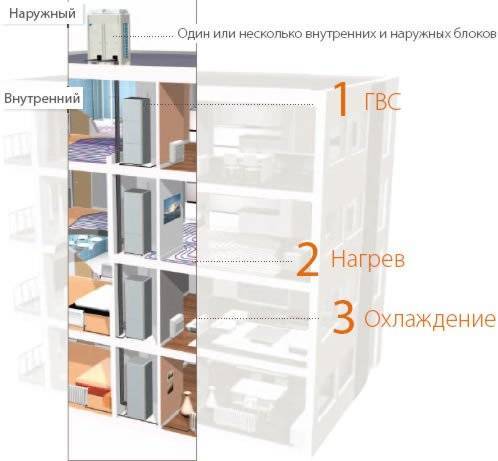

The use of modular boiler rooms in an apartment building. Click to enlarge.
Their implementation does not require the construction of a new building specifically for the boiler equipment - the entire installation is already "enclosed" in a container, moreover, the module is thermally insulated, and the assembly is carried out directly at the manufacturing plant.
Previously, such blocks were used as heating systems for temporary structures (change houses), but now they are offered (after a number of modifications) as an alternative to centralized heating.
But the best option for autonomous heating is an apartment heating system powered by a main gas pipeline or through a power supply network (depending on the type of boiler), the "core" of which is a wall-mounted boiler (gas or electric).
Why wall-mounted? Because wall-hung boilers have a number of advantages:
- Convenient in installation, easily hung on the wall using a set of fasteners (fasteners must be supplied with the boiler equipment)
- They are lightweight and small in size, do not take up much space in the room
- With their size, they have good power (10-25 kW) and are able to heat a room up to 100 m2 - and this is quite enough for one four-room apartment
- Manufactured as one- and two-circuit
If the owner of the apartment plans to install a wall-mounted gas boiler as heating equipment, then he should check the completeness of the equipment, namely:
- Boiler with two circuits (operating for both space heating and hot water supply)
- Combustion chamber - closed type
- The presence of a fan to provide forced draft (intake of fresh air from the street) and the removal of combustion products through the chimney
- Pump for forced circulation of the coolant
- Electronic ignition and full automation - for rational use of fuel
In the case of an electric boiler, which also works according to a two-circuit scheme (heating + providing the consumer with hot water), there will be much less difficulties: it will be necessary to obtain permission only for the allocation of an additional power line, plus agree on the insertion of direct and return pipes into the common water supply system.
The only exception will be electrode boilers without heating elements, which work to heat running water.
Natural gas use
The use of each of the given energy carriers has its own advantages and disadvantages. If your choice fell on autonomous gas heating in an apartment, then you will have to fulfill the following requirements:
- the organization - the gas supplier issues technical conditions, according to which it is necessary to develop project documentation for the connection of new gas-using equipment to the centralized network;
- the project must go through the approval procedure with the natural gas supplier;
- in the overwhelming majority of multi-storey residential buildings there are no built-in chimney shafts, only ventilation shafts, and it is not allowed to connect a boiler to them. It will be necessary to bring the coaxial chimney through the outer wall.It is better to coordinate this event in writing with the neighbors, whose windows will be next to the smoke diffuser;
- in the room where it is planned to install the gas boiler, it is necessary to provide good supply and exhaust ventilation;
- the connection of the heat generator to the gas main must be carried out by an organization that has a permit for such types of work.
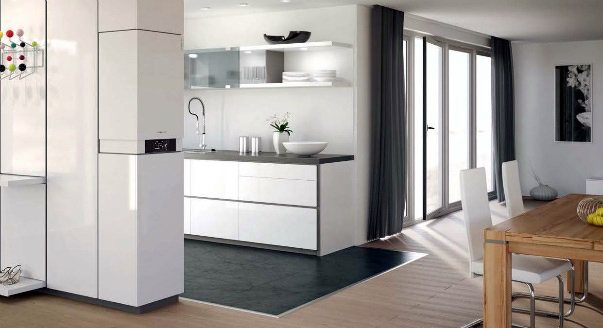

Note. Similar requirements are put forward if autonomous heating of an apartment building by a gas boiler house is planned. Only project documentation should contain an environmental impact assessment and be approved by the environmental department.
Autonomous heating in an apartment building
Is it possible to install autonomous heating in an apartment with your own hands? Although there is no legal ban on autonomous heating, it is still advisable to consult a lawyer, since some heating systems are prohibited. For example, water heated floors in apartments cannot be installed due to the fact that they can overload the system, thus depriving other residents of the house of heat.
In other cases, it is required to collect the necessary documents and submit them to local authorities:
- registration certificate for housing;
- a statement of abandonment of central heating;
- title deed;
- a diagram of a new heating system;
- the consent of all tenants of the apartment.
As a rule, such a seemingly simple request, such as giving up central heating and switching to heating itself, turns out to be a long-term bureaucratic problem.
Installation of autonomous heating in an apartment without the appropriate permission will become even more troublesome. This can end not only with a large fine, but also with legal proceedings, so before deciding to equip an apartment with any heating systems, you need to get advice from the relevant authorities and a permit for autonomous heating in the apartment.
Autonomous heating schemes for an apartment:
Advantages and disadvantages
If a permit has already been received for autonomous heating in an apartment building, then you can start choosing an alternative type of heat. It is easier to do this knowing the pros and cons of autonomous heating in the apartment.
For the first time, an autonomous heating system for an apartment appeared in Europe. Due to its clear advantages over centralized methods of space heating, it quickly spread throughout the world.
- The main advantage of the system is the significant cost savings. The owner of the apartment independently decides when to turn on and when to turn off the heating. For example, today there are thermostats in which you can set a timer for a certain time, which allows you to either completely or partially turn off the system when there is no one at home, and turn it on half an hour before the arrival of the tenants.
- The owner of the apartment can create the desired microclimate in each room.
- Pay exclusively for the heating meter and not depend on utilities and government tariffs.
When making a choice in favor of alternative heat, you need to know in advance how much autonomous heating costs in an apartment, and what kind of heating it will be not only economical, but also effective.
Among the disadvantages of such a system, the following nuances can be noted:
- Its regular preventive check once a year, for which you need to call a specialist. It's not that expensive, but still, many users either ignore this need, or simply forget about it.
- Installing even the best heating radiators for an apartment. you should be aware of possible heat loss. which are often caused by external walls, unheated from the bottom of the room or poor quality glazing.
Today, many construction organizations are building residential apartment buildings with ready-made autonomous heating systems.Such housing is in great demand, as it costs a little less and allows the owners to independently decide which type of heating to choose.
What does autonomous heating mean
As a rule, today either gas or electrical heating equipment is installed in apartments. In the first case, the most optimal option is a double-circuit gas boiler, since in this way it will be possible not to pay in housing and communal services for warm water. As for electricity, it is usually not used directly to heat a room, but indirectly, for example, to power a heat pump.
However, whatever your choice turns out to be, you will always have to take into account the upcoming dismantling of the old heating system, and this is usually very difficult. However, it will most likely not be possible to save money - you can use the pipes of the old system for new heating only if they are in good condition, that is, the house is new, or the heating has been changed recently. All this suggests that you will hardly be able to install autonomous heating in an apartment with your own hands.
Here we need the help of qualified specialists with extensive experience in this area. And, in general, heating with your own hands is a rash risk, since, for example, only a professional with a special permit can install gas equipment and start it for the first time.
We recommend: Types of autonomous heating of industrial premises
So, option number one is gas heating. For a city apartment, a modern double-circuit gas boiler is perfect, with electric ignition, a closed combustion chamber, a programmable thermostat and a built-in security group. It is this configuration that allows you to maintain the optimal temperature in the room at any time of the day. But you can also get a volumetric storage boiler - this will also allow you to save on hot water, and install a cheaper single-circuit boiler in the apartment.
Pros and cons
Since the automatics for gas boilers are already manufactured of high quality, then usually after starting and setting up, you can not worry about its operation. The foreseen security system will eliminate the likelihood of gas leaks and minimize other possible risks - with proper operation, of course.
If the apartment is small, then you can pick up a completely compact boiler of lower power, which will not take up much space, but will work almost silently. Moreover, prices for sufficiently high-quality domestic equipment vary in a wide range. Foreign (European) gas equipment is much more expensive. But both will be enough for many years of work.
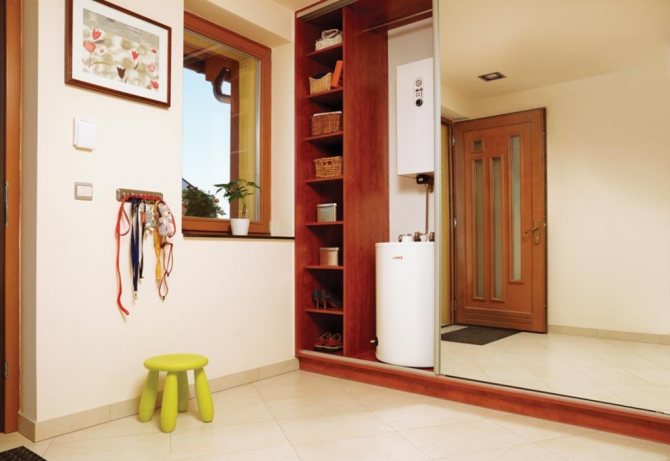

But I must also say about the disadvantages of autonomous gas heating in an apartment building. The probability of a gas explosion is, of course, minimal, but it still exists. Therefore, when installing the boiler indoors, you should also take care of a good ventilation system. Further. Regrettably, but the cost of gas for the population in cities is constantly increasing.
In addition, ventilation requires constant cleaning, since over time it becomes clogged with residues of combustion products - oily soot. And if a coaxial chimney is also used, then an unpleasant odor can penetrate into the apartment through an open window. By the way, in order to install the latter in the facade of the building, the consent of the relevant authorities may also be required.
We recommend: How much does the autonomous heating cost?
How to make autonomous heating in an apartment: features of the gas system device
As a rule, such a heating system is installed in 4 stages:
- installation of a gas boiler;
- the old heating system is turned off and dismantled;
- heating pipes for the new system and radiators are installed;
- gas equipment is connected.
When everything has already been installed, a specialist from the gas service should be invited to start the boiler.Only he will be able to ensure that everything meets safety requirements. By the way, in the autonomous heating system in the apartment, water hammer is practically excluded, and therefore there is no need to worry about this. This means that you can save a little on the strength of structures: for example, install aluminum radiators and polypropylene pipes reinforced with foil.
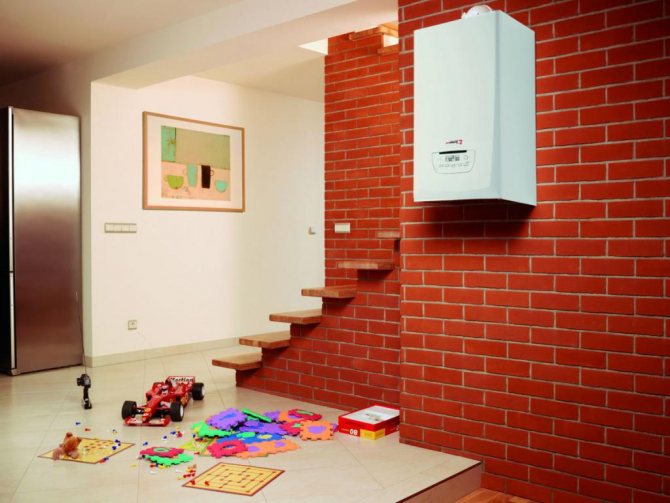

However, when installing such a heating system, you should still adhere to a number of rules:
- radiators are connected to the circuit not in series, but in parallel;
- when inserting radiators, a diagonal scheme is used;
- a thermal head is made on the connection of each radiator;
- a Mayevsky crane is screwed into the upper plug of each battery;
- a valve is installed on the radiator supply;
- installation of all batteries is carried out strictly according to the level;
- on the spill, clips are used to compensate for the expansion of pipes when heated;
- before starting the system, it is imperative that it be pressurized.
In addition, in order for the autonomous heating of the apartment to work reliably and efficiently, it is advisable to include a circulation pump in the system.
YouTube responded with an error: Access Not Configured. YouTube Data API has not been used in project 268921522881 before or it is disabled. Enable it by visiting https://console.developers.google.com/apis/api/youtube.googleapis.com/overview?project=268921522881 then retry. If you enabled this API recently, wait a few minutes for the action to propagate to our systems and retry.
- Similar posts
- How to make autonomous garage heating?
- Types of autonomous heating of industrial premises
- How to make autonomous heating in a private house?
- Which is better, autonomous heating or individual heating?
- Advantages of autonomous gas heating
- How much does autonomous heating cost?
Autonomous heating system: varieties
Autonomous heating using gas is perhaps the most common in Russia today. After all, gas, by itself, is still a fairly cheap fuel. And the principle of operation of such systems is very simple, and it consists in the following. A gas boiler is mounted, to which heating radiators are connected with pipes. The boiler heats water or another heat carrier, which naturally or forcibly (using a circulation pump enters) the batteries, which give off heat to the rooms.
For the stable operation of the entire system, you will also need an expansion tank, shut-off valves, as well as temperature sensors and devices for its control. By the way, such heating can not only provide you with cheap heat, but also cheap hot water all year round. The savings on this resource can also be doubled. You just need to purchase a double-circuit gas boiler at once.
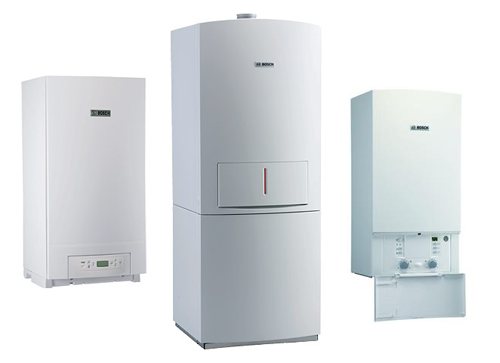

Double-circuit gas boilers
So, the advantages of such a system are:
- savings on heat in comparison with centralized heating several times;
- convenience - the boiler can be turned on and off when you need it, and the temperature in the system can be controlled;
- underfloor heating can be connected to such a system; and in general it is not difficult to combine it with other heating, for example, electric;
- you can use pipes and radiators, whatever you like; that is, get rid of old and bulky batteries, and put, for example, modern ones hidden under the panels.
However, there are also disadvantages of such autonomous heating:
- gas boilers must be checked and serviced annually;
- if a heating device breaks down, repairing it can cost you a pretty penny;
- you will have to monitor the heating system yourself - check if the pipes are leaking, if the radiators warm up evenly, if there is no airing in them, the circulation pump is stable and working, and so on.
However, all this only sounds scary. With competent installation, which is carried out by professionals, when buying high-quality elements, you can usually not worry about the operation of such a system and check it only once a year - just before the start of the heating season. But on the other hand, what a savings every year on heat and hot water!
Heating with electricity, of course, is not as economical, but safer and even convenient, because you do not have to seek permission to install a gas boiler in your apartment. Therefore, in recent years, electric boilers have become more and more popular.
It is quite easy to understand why, because there are much more options for such heating. So, here it is generally possible not to "fence" entire pipe systems, but to install heating elements directly into the radiators. And there are also electric underfloor heating, special radiators with high efficiency, convectors, infrared radiation, and so on and so forth.
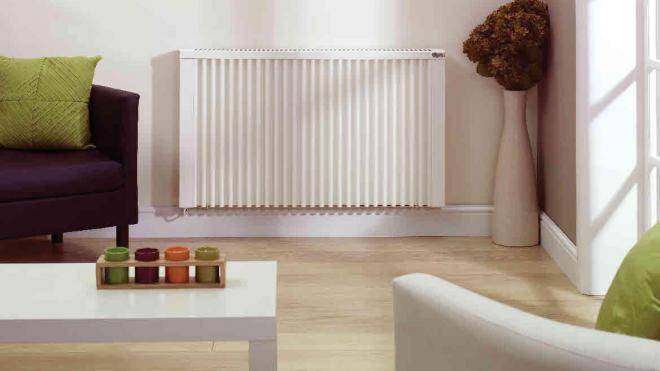

But not everyone understands that even such heating is more efficient than centralized, although in fact, here the savings are two-fold, with the use of modern devices and competent installation of the entire system. For comparison, we list below the advantages and disadvantages of autonomous heating with electricity. So the pros:
- a large selection of devices and their capabilities;
- it is not required to carry gas to the house or apartment, or to buy liquid or solid fuel, but there should already be light in any dwelling;
- the system can be powered, among other things, from alternative energy sources;
- significant savings compared to centralized heating;
- safety - you will not be poisoned by gas or combustion products of any other fuel.
Negative points:
when installing, it is important to use powerful wires, and your wiring must withstand them; that is, a separate line will be required; if the electricity is cut off, you will lose heat as well.
Heating system installation costs
Heating system installation
| Radiator installation heating | PC | from 2 000 ₽ |
| Installation recessed into the floor convector | PC | from 2 000 ₽ |
| Radiator installation heating (non-standard size, cast iron, design) | PC | from 3 000 ₽ |
| Installation distribution manifold cabinet heating | PC | 4 500 ₽ |
| A set of works for the installation of a heating system at home before 100 m² | from | 49 500 |
| The complex of works for the installation of a heating system at home before 150 m² | from | 52 500 |
| The complex of works for the installation of a heating system at home before 200 m² | from | 72 500 |
| The complex of works for the installation of a heating system at home before 250 m² | from | 87 500 |
| Specify the exact cost by phone | 84957446774 |
Heating system installation costs
Installation of underfloor heating system (warm floor)
| Water underfloor heating | m² | 500 ₽ |
| Junction collector cabinet for underfloor heating | PC | 4_500_₽ |
| Adjustment device underfloor heating temperature (Unibox) | PC | 2 000 ₽ |
| Regulation groups temperature warm floor (thermostatic valve, thermostat with clamp-on sensor, bypass valve, starter) | PC | 3 750 ₽ |
| Trunk pipes systems heating and pipe insulation (cross-linked polyethylene, metal-plastic) up to 20 mm | m / linear | 100 ₽ |
| Trunk pipes systems heating and heat insulation with pipe insulation (cross-linked polyethylene, metal-plastic) up to 32 mm | m / linear | 230 ₽ |
Heating system installation costs
Request a call
Call around the clock, we work without holidays and weekends.
Contact page
The emergency service works around the clock in Moscow and the Moscow region. In the nearest area the departure is planned according to the schedule.
8 (495) 744 -67 -74
Heating of private houses in detail by cost
- Heating 100 m² The cost of work is 49,500 rubles.
- Heating 150 m² The cost of work is 52,500 rubles.
- Heating 200 m² The cost of work is 72,500 rubles.
- Heating 250 m² The cost of work is 87,500 rubles.
Heating 100 m²
| Cost of work | from 49 500 rubles |
| Cost of equipment | from 120,000 rubles |
Heating 100 m²
Heating 150 m²
| Cost of work | from 52 500 rubles |
| Cost of equipment | from 200,000 rubles |
Heating 150 m²
Heating 200 m²
| Cost of work | from 72 500 rub |
| Cost of equipment | from 250,000 rubles |
Heating 200 m²
Heating 250 m²
| Cost of work | from 87 500 rub |
| Cost of equipment | from 300,000 rubles |
Heating 250 m²
Piping layout
While heating engineers are discussing the optimal heating scheme for a central heating house, the issue of competent piping in the house is being raised. In modern multi-storey buildings, the heating wiring diagram can be implemented according to one of two possible patterns.
One pipe connection
The first template provides for a one-pipe connection with top or bottom wiring and is the most used option when equipping multi-storey buildings with heating devices. At the same time, the location of the return and supply is not strictly regulated and may vary depending on external conditions - the region in which the house is built, its layout, number of storeys and construction. The direct direction of movement of the coolant along the risers can also change. The option of movement of heated water in the direction from bottom to top or top to bottom is provided.
One-pipe connection is characterized by simple installation, affordable cost, reliability and long service life, however, it also has a number of drawbacks. Among them, the loss of temperature of the coolant during movement along the contour and low efficiency indicators.
In practice, various devices can be used in order to compensate for the shortcomings in which a single-pipe heating scheme differs, a radiation system can become an effective solution to the problem. It is designed to use a manifold to help regulate temperature conditions.
Two-pipe connection
The two-pipe connection is the second version of the template. The two-pipe heating scheme of a five-story building (as an example) is devoid of the disadvantages described above, and differs in a completely different design than a one-pipe one. When implementing this scheme, the heated water from the radiator does not move to the next heating device in the circuit, but immediately enters the check valve and is sent to the boiler room for heating. Thus, it is possible to avoid the loss of temperature of the coolant circulating along the contour of a multi-storey building. The complexity of the connection, which is assumed by the two-pipe connection diagram of the heating battery in the apartment, makes the implementation of this type of heating a long and laborious process that requires large material and physical costs. Maintenance of the system is also not cheap, but the high cost is compensated by high-quality and uniform heating of the house on all floors. Among the advantages that a two-pipe circuit for connecting heating batteries gives, it is worth highlighting the possibility of installing a special device on each radiator in the circuit - a heat meter. It allows you to control the temperature of the coolant in the battery, and using it in the apartment, the owner will achieve significant results in saving money on utility bills, because he will be able to independently regulate the heating if necessary.
Determination of boiler output
The costs of installing individual heating in an apartment will justify themselves if the boiler power is correctly calculated. They take into account the peculiarities of the local climate. The heating boiler capacity is sufficient for the southern regions, which will be from 0.7 to 1 kW, in the north of the country - 1.5 to 2.0 kW.
To calculate the power of the boiler, the following formula is used: W of the boiler = S xWsp / 10, where S is the area of the room, Wsp is the power of the boiler per 10 sq. M.
This simple calculation will help you when choosing a gas appliance.
It is also necessary to choose the right scheme for individual heating in the apartment.
The two-pipe system is much more efficient. It provides an even distribution of heat throughout all rooms. In addition, the one-pipe version is not suitable for all radiators.
Autonomous heating: pros and cons
The independence of the system is its main advantage. All advantages and disadvantages are consequences of autonomy.
- Heat supply mode - set according to the wishes and capabilities of the people living in the apartment, and not the capabilities of the communal farm of the apartment building.Extend the heating season or make it shorter, turn it off if the dwelling is left for a long time, or set it to a minimum heating level - any option is available and feasible.
- Heating regulation - the air temperature in the apartment is determined by its occupant. In most cases, an independent system allows you to install a thermostat on each radiator, which makes it possible to create an individual thermal regime.
- Savings - despite the hefty initial costs - if we are not talking about an electric boiler, the cost of heating the apartment and the maintenance of the system itself are significantly reduced compared to paying for centralized heating services.
- In the case of installing a double-circuit water heating boiler, it is possible to independently supply the dwelling with hot water all year round.
The disadvantages of autonomous heating are associated with the fact of its installation and the need to independently take care of its normal functioning.
- Installation - all elements of the system are purchased independently, installed by their own hands or with the help of specialists. The initial expense is quite significant. The photo shows a working moment.
- The installation of a heating system is associated with the partial destruction of wall partitions, the integrity of the floors, and so on. Most likely, after this, at least cosmetic repairs will have to be carried out in the home.
- Instrument repair and maintenance - carried out by representatives of service centers on various conditions. But in any case, paying for them is only a problem for the owner. Deciding whether this is a disadvantage or an advantage is sometimes difficult.
- Installation of autonomous heating requires a permit. Of the above, this circumstance is perhaps the most difficult and tedious, judging by the reviews. However, these requirements are not only a product of bureaucratic activity, but also prevent the installation of illegal uncertified equipment, which poses a serious danger to all residents of an apartment building.
The convenience and efficiency of any version of an independent system so much exceeds the costs of effort, time and money for its installation that there can be no two opinions: if the installation is fundamentally possible, then it is worth implementing it without putting it on the back burner.
Where to begin?
The first step is to formalize the official refusal of district heating services and obtain a permit for the installation of autonomous heating of the apartment. This procedure is complicated, in order to arrange autonomous heating as expected, you need to spend a lot of time and effort.
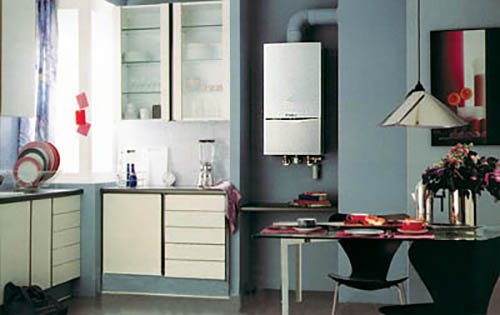

Note. In the countries of the former Soviet space, there are various legislative acts regulating the procedure for organizing individual heating in apartments. Some of them, for example, in Ukraine, directly prohibit the arrangement of such heating.
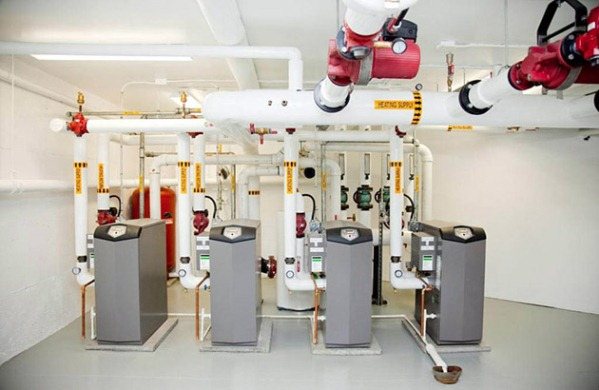

We will not describe the passage of the registration procedure, there are corresponding Internet resources for this. We will only touch on the Ukrainian legislation, according to which there is only one way to make autonomous heating: the residents of an apartment building must create their own association (OSBB). It can decide on the construction of an individual boiler room that serves the entire building. At the same time, the scheme of the heating system of an apartment building remains unchanged, only it is reconnected to another heat source.
Requirements
It is necessary that the unit has all the appropriate clips:
- Flame presence control.
- Traction and temperature monitoring.
- In the absence of fire, the shut-off valve must operate.
Therefore, buying boilers is better than those manufacturers who have been on the market for more than one year. Also, the annual maintenance should be carried out by the relevant authorities, and this cannot be denied.Today, gas distribution stations not only carry out the gas supply procedure, but also offer high-quality boilers at affordable prices. In this case, they are already fully responsible for the entire process of the device.
Independent heating what is independence
The main task that residents of a city apartment, who have expressed a desire to become independent from centralized heating, may face, is obtaining permission. Without official documents permitting to disconnect from central heating and a finished project for future autonomous heating in an apartment, it is impossible to dismantle the equipment.
Important! Unauthorized actions to turn off and dismantle central heating elements in the premises of an apartment building can be regarded as an administrative offense. If such facts are revealed, the apartment owner is forced not only to pay a fine, but also to restore the dismantled equipment at his own expense.
In the process of solving organizational issues, one should not leave the development of the project for later. In other words, if you decide to equip decentralized heating in your apartment, you will have to decide in advance on which type of autonomous heating to give preference to.
The concept of "independent" in relation to a city apartment looks rather arbitrary. Unlike a private house, where the owner has great technological capabilities, a city apartment has limited resources. In private households, you can install autonomous heating of almost any kind. With the desire of the homeowner and certain finances, you can really achieve complete independence from centralized energy suppliers.
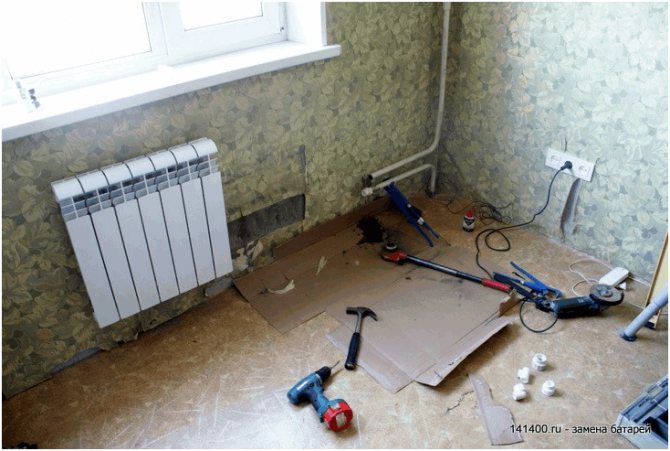

The main advantages of independent heating systems are as follows:
- the ability to independently adjust the heating intensity of residential premises
- quick start and quick shutdown of autonomous heating systems;
- a real opportunity to achieve savings on energy costs;
- maintaining the optimum permissible temperature in the apartment at any time of the year.
The presence of in-house communications, the layout of apartments and strict technical standards do not allow apartment owners in an apartment building to use stove and air heating, and other alternative heating options. In this case, you have to be content with gas or electricity. Any interruptions in power supply or gas supply will nullify all your independence. The only thing that can be done is to equip autonomous home heating, using one of the main sources, and keep the second as a backup, fallback option.
Note: when submitting documents for disconnection from central heating, you will have to attach an alternative heating project for your apartment. The choice of energy sources is not great, the project can be designed for the installation of gas heating equipment or electric. Any other options for independent heating will not be approved and will be rejected.
Installation recommendations
Any homeowner may have a natural question regarding electric heating. Why put up a boiler and fence pipes with radiators when you can lay underfloor heating cables or carry out heating around the perimeter of rooms with baseboard convectors? The argument in favor of a water system is one, but important: it can be connected to any heat source. For example, tomorrow the electricity tariff will rise, and you have a heating circuit made of cable mats, it is impossible to switch to another energy carrier.
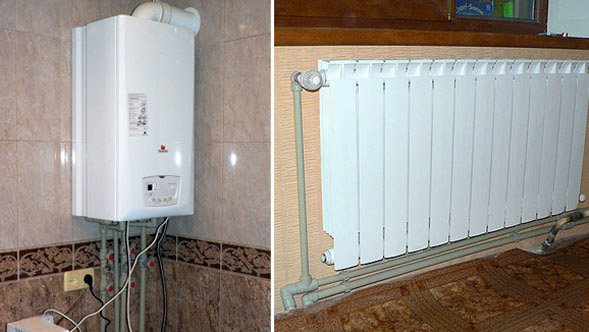

Another tip is that when organizing a new heating system, it is better to replace the radiators as well. But before starting the installation of autonomous heating, they must be properly disconnected from the risers.To do this, the battery is dismantled together with the bypass, and a piece of pipe of the same diameter as the riser is inserted into the resulting gap.
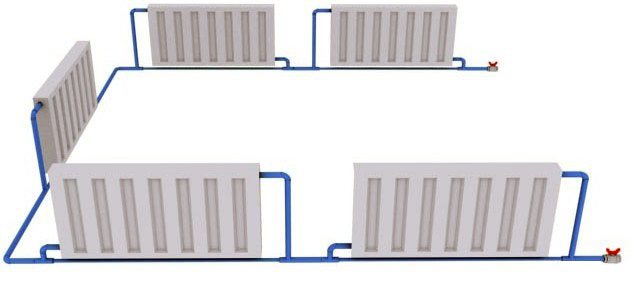

The operation is performed with a steel pipe using welding or metal-plastic pipe on threads and press fittings. Since a circulation pump is always built into wall-mounted boilers, a single-pipe system with no more than 5 radiators is suitable for heating a small one-room apartment with an area of 35-40 m2.
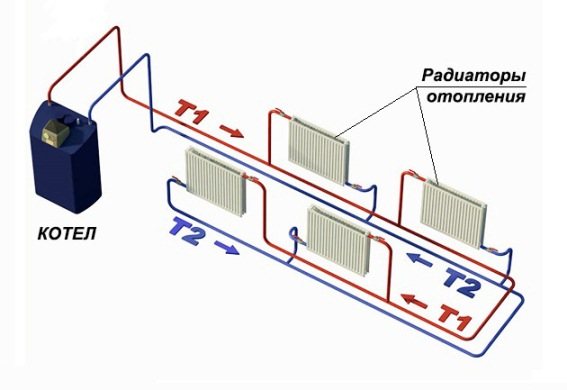

If the area of the dwelling is larger, then for your own convenience it is recommended to make a two-pipe system with lower wiring. As an example, the diagram of autonomous heating combined with DHW is shown below:
